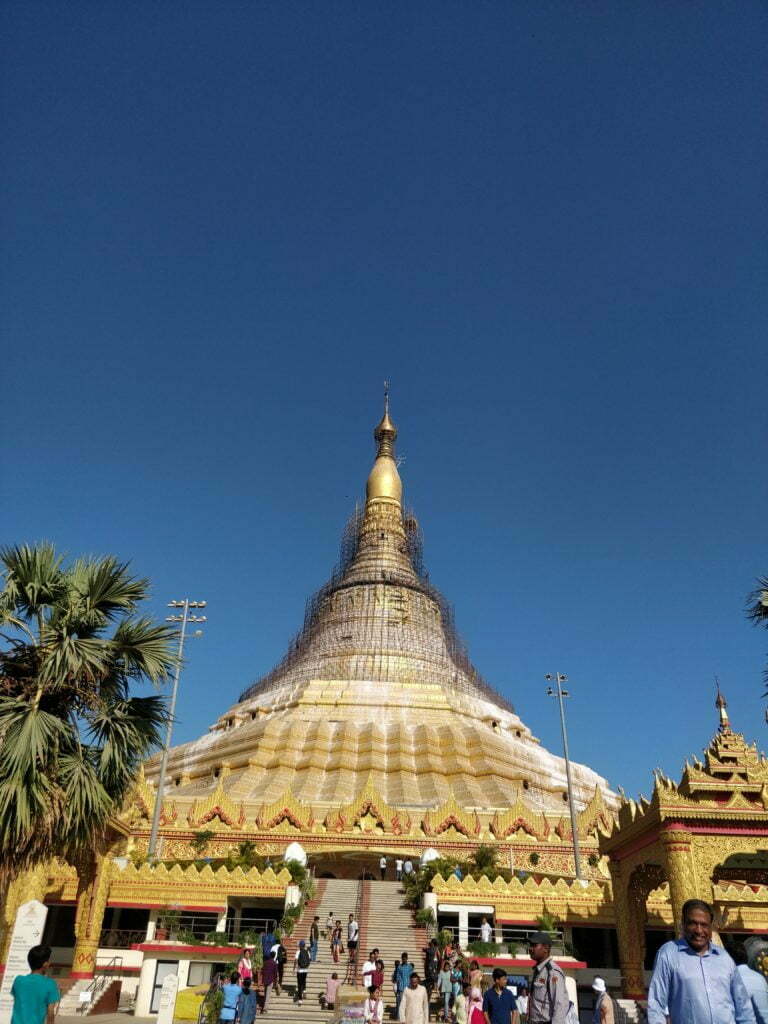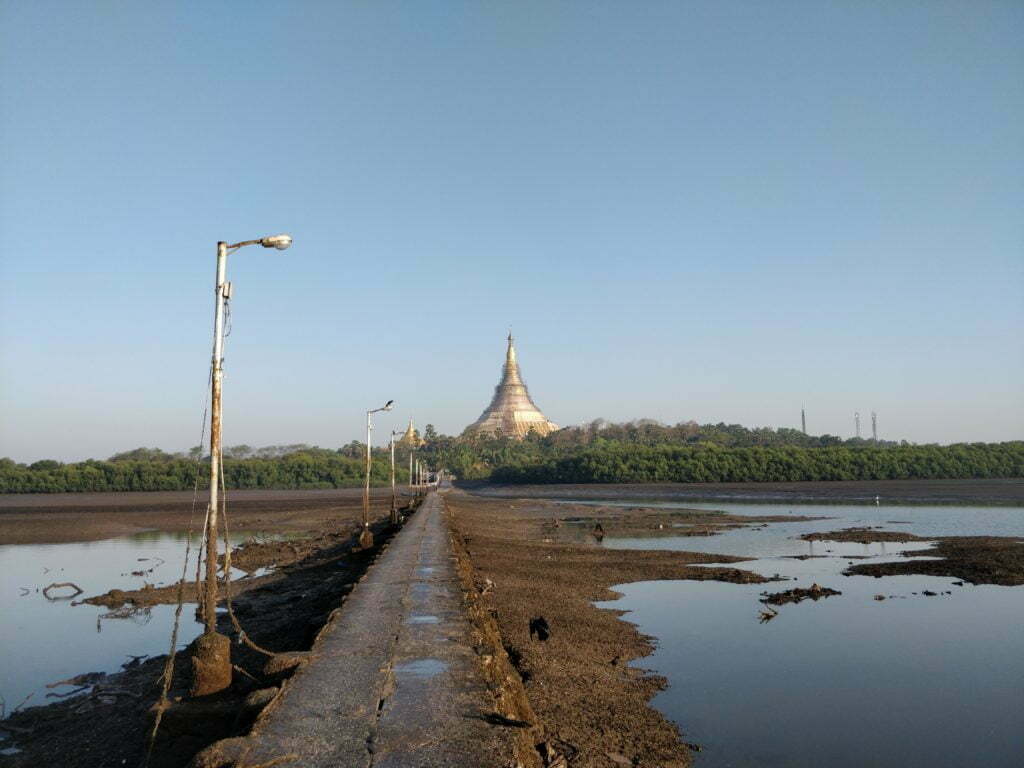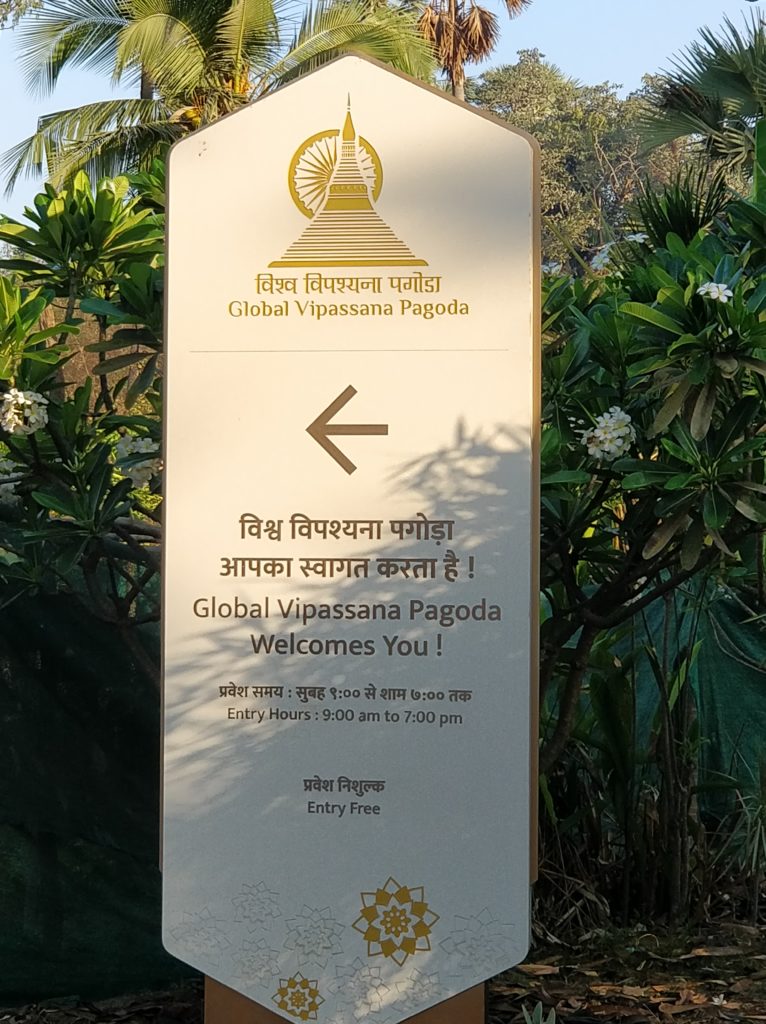10 days of the Vipassana Meditation Course is very insightful. A wonderful ancient meditation technique that I learned at Global Vipassana Pagoda, a beautiful monument of peace and harmony.
I have come across many different meditation techniques since my childhood. I have been practicing meditation regularly for several years. Meditation is a wonderful practice to include in your daily routine. It is a very effective practice to look inward and connect to your innermost self. If you want to know more about meditation please read the article on Meditation. This article will give you brief information about Vipassana Meditation.
As a part of this curiosity for the elusive infinite happiness, I became curious about the Vipassana meditation technique. I learned the Vipassana meditation technique and would like to share some of my learnings from the 10-day course that I completed at the Global Vipassana Pagoda in April 2019.
Learning Vipassana Meditation at Global Vipassana Pagoda
What is Vipassana Meditation?
The Vipassana meditation technique is one of the most ancient forms of meditation. It is believed that Gautama Buddha taught this technique to his followers as a means to experience reality as it is. Vipassana means insight or a clear awareness of exactly what is happening as it happens. This technique helps purify the mind. It also helps in the art of living and making positive contributions to society.
This technique is attributed to Buddha’s teachings in 2500 BC. The technique by itself is non-sectarian and learning it does not require you to change your faith. Many times religions of the world get entangled in ritualistic tendencies and dated dogmas and the real purpose of an individual’s spiritual development or evolution is left by the wayside.
This technique originated in ancient India and was brought back to India from Burma by S.N. Goenka. It has now spread all over the world from India.
10 days Vipassana Meditation Course
One has to undertake a 10-day residential course to learn the Vipassana Meditation Technique.
What is the mental preparedness needed to do the Vipassana Meditation Course?
Moral Conduct
You have to maintain moral conduct during the course duration and in daily life after the course. This is practiced by following the Five Precepts:
- to abstain from killing any being,
- to abstain from stealing,
- to abstain from sexual misconduct,
- to abstain from wrong speech,
- to abstain from all intoxicants.
Noble Silence
All students must observe Noble Silence from the beginning of the course until the morning of the last full day. Noble Silence means silence of body, speech, and mind. All forms of communication with fellow students, whether by gestures, sign language, written notes, etc., are prohibited.
Students may, however, speak with the teacher whenever necessary and they may approach the management with any problems related to food, accommodation, health, etc. Even these contacts are to be kept to a minimum. Students should cultivate the feeling that they are working in isolation.
Following the course timetable
The student is required to follow the course timetable where the day starts at 4:00 am and you go to bed around 9:30 pm.
Typically it involves 10-12 hours of practice of meditation techniques.
Code of Discipline
Besides the above requirements, there are other requirements for the student to follow. You are requested to go through the complete code of discipline before enrolling for a course.
What are the techniques one learns and practices during Vipassana Meditation Course?
What is the path of learning that is taught?
- You practice moral conduct. (called Sila)
- You learn techniques to improve your concentration and practice. them. (called Samadhi)
- You start experiencing insights, that purify your mind. (called Panna or Wisdom)
How does one practice moral conduct in these 10 days?
The 10 days course is designed in such a way that the environment is conducive to the practice of moral conduct. For example, you live in a secluded environment in silence. Needs for basic food and rest are met as per the course timetable. There is segregation of men’s and women’s quarters, dining areas, meditation areas, and walking areas.
What are the concentration techniques you learn and practice?
We are normally aware of the human form. We learn and practice body/breath awareness and sensation awareness.
How does the course help one attain wisdom or Panna?
There are three ways of gaining wisdom. Wisdom is gained by listening to others. Intellectual wisdom gained through analytical understanding.
Wisdom is based on direct personal experience. Focus in the Vipassana meditation technique is to acquire wisdom through personal direct experience.
Buddha’s Eight Fold Noble Path to wisdom/enlightenment or to end suffering is:
- right speech
- right action
- right livelihood
- right effort
- right awareness
- right concentration
- right thought
- right understanding
You learn to develop these qualities through the Vipassana Course and subsequent practice.
Body/ Breath Awareness (called Anapana)
Over 2 days you learn to observe your breath. This help in improving concentration. You slowly move from observing gross movement over a larger area on the face to the lightest touch of air.
If you want to try out a mini version of anapana technique, you can try it out in 10 minutes as taught by Goenkaji himself. I used to work with an organization the entire workforce used to practice this technique as part of their morning rituals.
Sensation Awareness (called Vedana):
From breath awareness, one learns to become aware of sensations in the body. You start part by part and then learn to scan the whole body in a sweep.
Understanding the Nature of the Sensations
You start witnessing the nature of change in the sensations. Anything that changes is not permanent. They are of the nature of impermanence.
You start witnessing some pleasant and some unpleasant sensations. With practice, you also start experiencing their impermanence.
Some pleasant or unpleasant sensations do not change very easily. These require much more practice and effort. That is the reality if that moment. One has to learn to accept reality as is. These may be due to our false identification or ego that is holding us back from experiencing pure consciousness.
Experience of Insights (called Vipassana)
With the practice of the Vipassana technique, you start perceiving the nature of the mind and matter within your own body. You start recognizing the reacting tendencies/mental conditioning. You learn to overcome these tendencies and experience lightness through these insights. As days pass by, with dedicated practice you will start experiencing very empowering insights.
Mental Conditioning Awareness: (called Sankhara)
Through sensation awareness gradually you start becoming aware of mental conditioning. These manifest as Gross and Subtle Sensations in the body.
The practice of Equanimity (called Upekkha)
The reactive tendencies of the mind manifest as gross and subtle mental conditioning. You learn to practice equanimity by learning to observe this mental conditioning without any judgment. This helps purify the mind.
The practice of equanimity makes one less reactive. It gives one control over the mind to exercise the right thinking.
The practice of overcoming likes and dislikes
The three main impurities of the mind are ignorance of the real Self which leads to false identification. The ultimate reality is beyond mind and matter. This false identification with mind or matter leads to our false likes (Raga) and false dislikes (Devesh). With the practice of Vipassana, you look at them in an equanimous way, and gradually with an effort the likes, dislikes, and ignorance start fading away.
A purer mind becomes a happier mind.
Vipassana Meditation in Cells inside the pagoda domes
The smaller domes in the complex house meditation cells. After one has learned the Vipassana Meditation Technique, the meditators are given access to cells to meditate as part of the vipassana meditation course.
Because of the height of the dome structure and other ambient conditions, the feeling inside the cell structure is like sitting in a cave. A little duct with some airflow is available to the meditator. You can control the airflow to suit your needs.
Experience in a group meditation in the central hall, in the cell, and in your residential quarters are different.
Selfless Love (Metta Bhavana)
The four qualities of a pure mind are
- Metta or selfless love
- Karuana or compassion
- Mudita or sympathetic joy
- Upekka or equanimity
Equanimity practice starts with Vipassana practice. Once you reach a stage of pleasantness in your meditation you are encouraged to wish well for all beings in the deep state of your meditation. The practice is to deepen the quality of selfless love.
What are some of the challenges in completing the Vipassana Meditation Course?
Maintaining posture
If you are not used to sitting cross-legged, you can request a chair/stool. The idea is to maintain a stable posture in meditation. Body and mind are connected. As the body becomes steady, the mind also becomes steadier. It is easier to observe a slow mind versus a fast mind.
Long hours of sitting in meditation
Sitting either on a chair or stool, if you are not used to sitting in a stationary pose for long hours, can be physically challenging. Mind also plays its tricks. The various thoughts that surface might affect you and the impulsive responses can cause movement of the body parts.
Thought of Quitting
After 2/3 days the intensity of the meditation practice can be unsettling. We were told that many people get this feeling of quitting. I wanted to complete the course when I started and reinforced the same thought at that stage. In case of difficulties, one can contact the teacher. I believe this helps many people who are on the verge of quitting to help them gain confidence and reinforce their commitment to completing the course.
Dealing with disturbances of the mind during meditation
- Experience of Pain, Sweat, Heat, Cold, Sleep, and other difficulties may crop up even when sitting quietly in meditation. With effort and determination, you will learn to overcome these disturbances gradually.
- Improvement in posture and soft cushions can help alleviate physical discomfort. One has to persist with equanimity and understanding of impermanence in meditation to overcome psychological discomforts.
- Heat and sweat can be reduced by eating non-spicy food and frequent showers.
- A blanket can be used to overcome cold.
- Light food and enough rest can help overcome sleep during meditation.
Night Sleep Disturbances
Silence and meditation practice makes the mind very alert. Although you will have a busy schedule, most of the time you are meditating, hence the mind is quite rested. You remain so alert that your body may hardly need any sleep. This can be quite an unusual experience.
Other challenges
You may be used to a certain routine and have personal preferences. In the environment in which you undertake the training, you will be provided with nice food, accommodation, and enough rest. But you may need to adjust depending on your existing lifestyle. This is a very small price to pay and should be the least of one’s concerns if you are seriously looking to subject yourself to learning.
What are the benefits of completing the Vipassana Meditation Course?
Sense of Achievement
If you have ever climbed a mountain, it seems difficult to begin with. During the climb, you may encounter various challenges. Once on the top of the mountain, you have this sense of accomplishing something worthwhile.
In life right from childhood, we keep achieving. However, when we look back there are some achievements that are special.
The insights that you gain can give you a feeling of special achievement. You may start feeling like sharing your experience and encouraging others to learn the technique.
Increase in Awareness
We use smartphones these days. One of the things that keep improving in the newer versions of smartphones is the processor. The newer processor as the name suggests gives you more processing power. The advanced phones do not hang or crash. Similarly, you will be getting an upgrade of your own software where you have a wider vision and faster processor.
Mindfulness
A smarter phone does not make you smarter. However, if you can start focussing on the tasks at hand and execute them efficiently, you feel free after completing the tasks.
Focussing on the present moment becomes easier. Task execution becomes better.
Right Thoughts
Having experienced a paradigm shift in the way you look at the world and your inner world, makes a difference to the flow of thoughts within.
This opens up new thought currents which are more empowering. This drift creates a movement in the direction of the right-thinking
Right Actions
Everything in the world is created twice. First in the mind, then it manifests in a form that can be seen by others. Our behavior, our choices, and our intentions post the course will get affected.
Inner Peace
Inner peace experienced anytime in life has a lasting impression on us. The experience of peace gives you a safe harbor to go back to.
This peace is not something that needs to search outside, but something that is within.
The environment outside of the course may not be conducive to this peace but at least you have the capability within you to reclaim your peace. It will become easier than before for you to bounce back to your peaceful state having experienced the power within.
What is one expected to practice on completion of the Vipassana Meditation Course?
Daily practice
- One hour of meditation in the morning and one hour in the evening,
- Five minutes while lying in bed before you fall asleep and after you wake up.
Weekly Group Practice
- One hour with other meditators practicing the technique of Vipassana.
Annual Practice
- A ten-day or longer course once a year
How do you enroll in a 10-day Vipassana Meditation Course?
There are over 300 locations across the world where you can learn the Vipassana meditation technique. The application process is online. One can apply to the course 3 months in advance of the scheduled course date. It is better to apply early as the seats get filled up quickly. Click here to locate a center near you and apply.
Documentary on Vipassana Meditation Course
Vipassana Meditation Course at Global Vipassana Pagoda?
Why Global Vipassana Pagoda?
- It’s a unique place. It is one of the largest stone monuments in Asia.
- The structure contains the biggest pillar-less stone dome on earth.
The pagoda is to serve as a monument of peace and harmony. - The Global Vipassana Pagoda is declared as one of the “Seven Wonders of Maharashtra” by Maharashtra Tourism Development Corporation (MTDC) in partnership with ABP Majha, a Marathi news channel on 6th June 2013.
Meditation Facilities at the complex
- The central dome has the capacity to seat around 8,000 Vipassana meditators.
- The complex also houses the Dhamma Pattana Vipassana Centre which conducts Vipassana courses, especially for Business Executives, professionals, and government officials.
How to Reach?
- By Road from Mumbai:
- Take Western Express Highway (WEH), turn left to Kashimira, and drive down to Mira-Bhayander road. It will take around 30-45 minutes from Kashimira
- From Bhayandar – MBMT Bus no.4
- By Ferry
- Near Malad – Marve Creek
- Near Borivali – Gorai Creek
Some Pictures from the Visit






